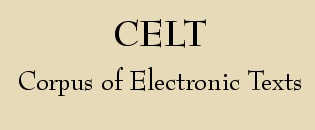Fragmentary Annals: Manuscript History
Source: Joan Newlon Radner (ed. & trans.)
Fragmentary Annals of Ireland, Dublin: DIAS 1978, vii–ix
Very little is known about the text from which the Fragmentary Annals
in Brussels MS 5301–5320 survive. Most of the scanty evidence about the
manuscript history of the text is contained in the annals themselves. The
Brussels MS is the only copy of the text known to exist. Its source, according
to the headnote and to notes within the text, was a transcription (now lost)
made by Dubhaltach Mac Fir Bhisigh in 1643
(see his dated
signature in entry FA 388) for Dr. John Lynch, from a vellum manuscript
(also now lost) of Giolla na Naemh (Lat. Nehemias) Mac Áedhagáin
Senior, a member of the Ormond legal family in whose school Dubhaltach is known
to have studied. If this Giolla na Naemh was the writer or the most famous
owner of the manuscript, rather than simply its owner at the time Dubhaltach
used it, he may, as Professor Pádraig S. Ó Riain has suggested,
be the same as the Giolla na Naemh Mac Áedhagáin whose son of the
same name died in 1443
(see AFM
1443.11); thus Dubhaltach's exemplar may possibly be dated no later than
the beginning of the fifteenth century.
Of the Mac Áedhagáin manuscript Dubhaltach tells us only
(see FA 366, p.
134), that it was kept in a broken book; this is attested by the fact that
entries for 662–704 A.D. follow those for 716–735 in the
transcription, and by the large and small gaps throughout the text. (The
disconinuities between Sections are obvious: small breaks in the text occur
chiefly in Sections IV and V, for example, in FA 338, 349, 365, 366,
377, 387, 423, 429.) The Mac Áedhagáin book is not given a name
in the text of the Fragmentary Annals, and indeed it may have been so
broken that Dubhaltach did not know its name, but there are in other
seventeenth-century sources some hints that it may have been—or may at
least have been a copy of or extracts from—the Book of Cluain
Eidnech.
In Foras Feasa ar Éirinn Keating lists a Leabhar Fionntain
Chluana hEidhneach among the books of senchus of which the originals
or copies still existed in his time
(see Vol 3 p.
32), and he tells the story of the battle of Belach Mugna in nearly the
same words as the Fragmentary Annals, stating that his account comes
from a "sein-leabhar annalach Cluana hEidhneach Fionntain i
Laoighis." (see Vol. III p.
212). The content and some features of the text of the Fragmentary
Annals make it seem quite possible that the Annals were copied and
preserved for some time at Cluain Eidnech. If the Book of Cluain Eidnech
did contain this text, however, it is not likely that Keating ever had access
to the book itself, since he made so little use of it. Of the material in the
Fragmentary Annals, he reproduces only the Cath Belaig Mugna story,
though it is reasonable to suppose that many of the other
stories—particularly those concerning kings of Tara—would have been
of interest to him. Most probably Keating had copies of only a few selections
from the book. His other two extracts from it provide clues to the book's
nature and history. He mentions Leabhar Cluana Eidhneach as the source
of his accounts for the Synod of Ráith Breasail (A.D. 1111) and the
Synod of Kells (A.D. 1152). A MS collection made for Sir James Ware gives a
Latin account of the Synod of Kells almost identical to Keating's, headed
"Ex Ms. Libro vetust. D. Flannani mac Ægain" (in BL Add. MS
4783, f.34.; I am grateful to Professor F.J. Byrne for this
reference.)—again, a vellum MS in Mac Áedhagáin possession
is linked to Cluain Eidnech, and there is a high probability, then, that the
Fragmentary Annals that Dubhaltach copied from the Mac
Áedhagáin vellum came ultimately from the Book of Cluain
Eidnech. That book seems to have been a collection of various texts dealing
with secular and ecclesiastical history. Considering their dates, content, and
style, it seems likely that the lengthy and technical accounts of the two
synods originated from a different text from the Fragmentary Annals. And
it is probable, too, that the Book of Cluain Eidnech, when it came into
the possession of the Mac Áedhagáins, contained a copy of a third
text, the Bóroma, as well.
Although the text in the Brussels manuscript is the only known copy of the
Fragmentary Annals, we do have access still to versions of two of the sources
that were incorporated into the FA compilation. One of these sources is
represented by the other existing texts of Irish annals for the pre-Norman
period; the relationship between these and FA will be discussed at length
later. The other source is a fragmentary chronicle containing many of the same
tales as the earlier portion of FA; it survives in British Museum MS Egerton
1782, ff. 56a-65a, written in 1517 A.D., and was edited as
Mionannala
by Standish H. O'Grady in Silva Gadelica. The Mionannala seem to
be copied from a text that was an important source for FA; comparison of the
form of Mionannala with that of FA provides valuable information
concerning the process of compilation of the text from which the Fragmentary
Annals survive.
Copyright © Dublin Institute for Advanced Studies, 1978 –
extract reproduced on the CELT website by kind permission of the copyright owner.

